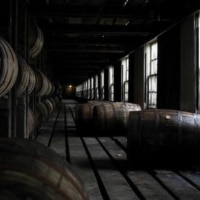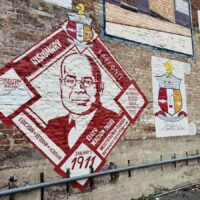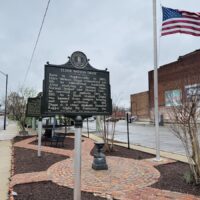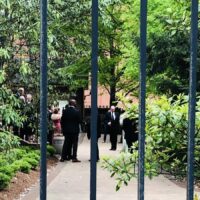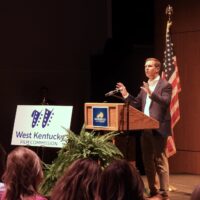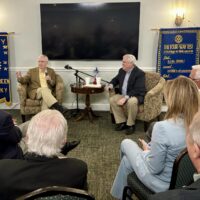In 1920, Franklin Delano Roosevelt, vice presidential hopeful, visited Hopkinsville. Children lined the sidewalks at Virginia Park to hear him speak. More than 75 years later, Sarah Dalton Todd keenly remembered being an onlooker. Virginia Park was less than a block’s walk from the Dalton House — so close that the Daltons could see the bandstand from their back windows.
When Roosevelt visited, Virginia Park had become the heartbeat of Hopkinsville public life, and the bright new neighborhood that had emerged along its Seventh Street boundary reflected this. Those who opted to build homes here were the new money and the new movers and shakers of Hopkinsville politics and business. They were tobacconists, contractors, and brick manufacturers. East Seventh Street was beautiful and vibrant.
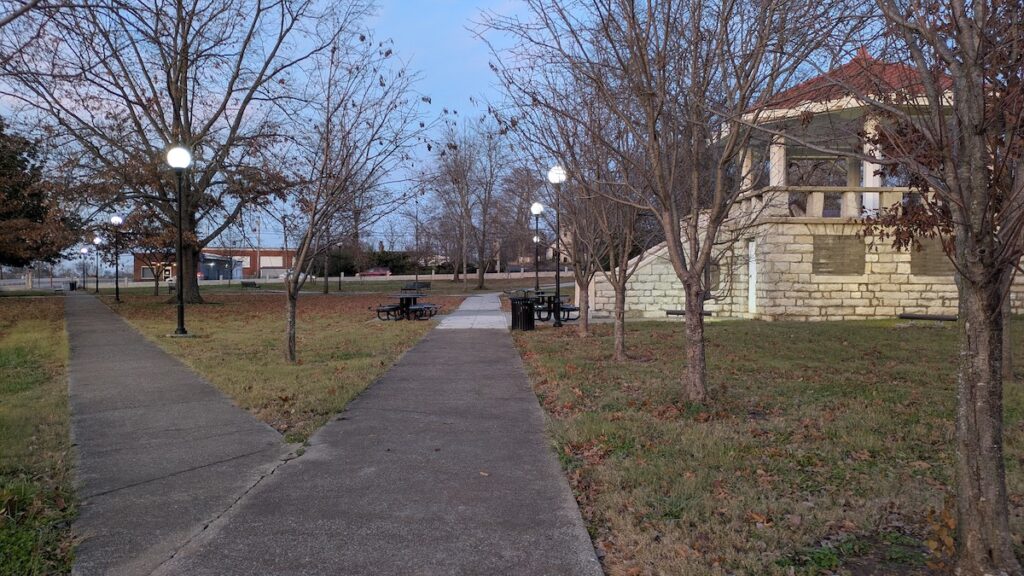
Designating the East Seventh Street Historic District
The East Seventh Street neighborhood was listed on the National Register of Historic Places in 1983, largely through the efforts of Chris Hall, who moved to Hopkinsville from North Carolina to work for International Paper Co. He and his partner, Tracy Calhoun, owned the Dalton House in the early 1980s. Hall was enthusiastic about the house and the neighborhood’s history. At the time both were listed on the National Register, Hall was just 30 years old.
The East Seventh Street Historic District was small. It began at Campbell Street and ended at Belmont Street. Including Virginia Park, it encompassed 24 properties — 19 contributing and 5 non-contributing. Originally, the district was marked with a wooden sign. After Hall’s untimely death from a heart-attack in 1986, this was removed to the Dalton house’s basement and replaced with a granite marker in the sidewalk.
Meet the Smiths
I first became curious about the historic district because of the empty lot next our house. While planting trees, I unearthed pottery sherds. The ceramic bits had a hand-painted light brown design and a blue rim. Naturally, I wondered about the house that had been on the lot and the people who had lived there. The first place I looked was the National Register district listing.
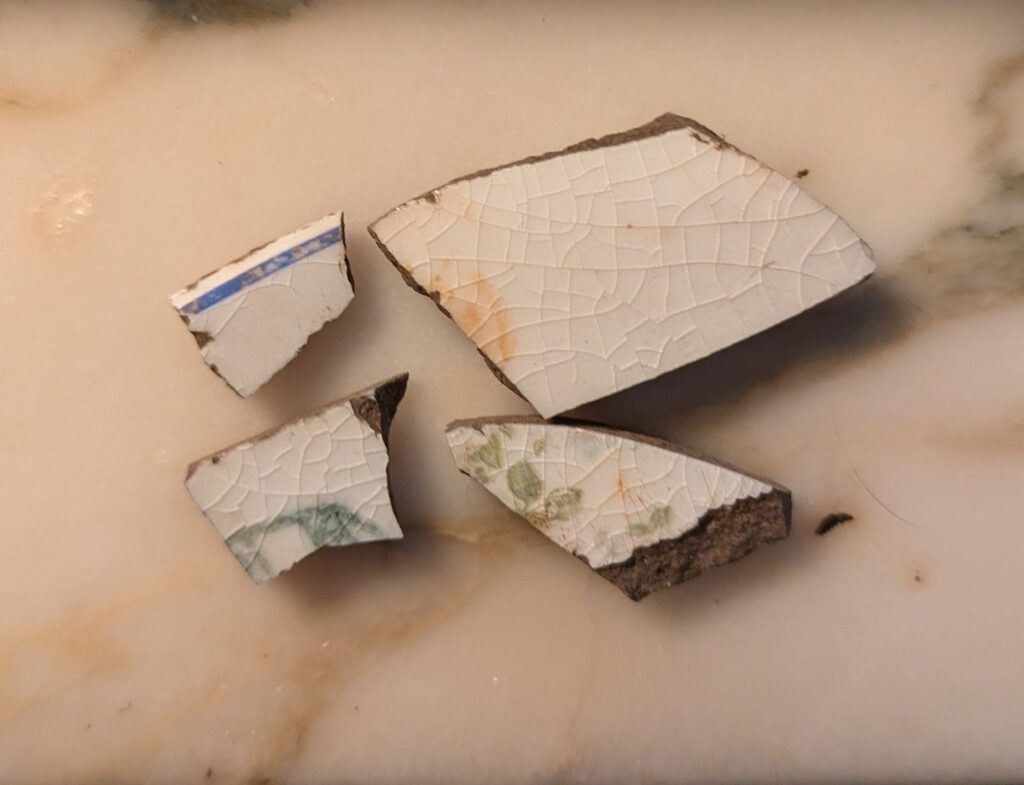
Sure enough, there was a photo of the house. When the East Seventh Street Historic District was created in 1983, the two-story frame house at 707 E. Seventh St. was included as a contributing property. It had, however, recently suffered a fire, and the document listed its future as “yet unknown.”
The house was built before 1900. The earliest owners I found in the city directories and census records were Thomas and Nancy Smith. They had probably built the house and were living there in 1900. This house was the Smith family home for nearly 50 years. Both Thomas and Nancy were transplants to Hopkinsville. Thomas, better known as Tobe, was a native of Lebanon, Tennessee. He came to Hopkinsville as a young man right after the Civil War and drove a stagecoach between here and Russellville. He worked his way up to buying his own livery stable and later became a policeman. Nancy was a native of Mayfield.
The Smiths had five children. Two died young. Their son Edwin moved to Nashville, but Harry stayed here and worked as a linotype operator for the Kentucky New Era. He never married and continued to live with his mother after his father’s death in 1910. The Smiths’ daughter Ruth also lived at home. When she married John Lawson, a postal clerk, they moved next door. John and Ruth Lawson’s house, 801 E. Seventh St., still stands and is a contributing building in the historic district.
Nancy died in 1945, well into her 90s, and Harry moved next door with his sister and brother-in-law. He died tragically the next year. While walking through Virginia Park one night, Harry was robbed. The robber did not physically harm him, but Harry’s heart could not handle the shock. He made it back to the Lawson residence and later fell into a coma and died.
Though not as wealthy as the neighboring Daltons or Davises, the Smiths represent the growing middle class of entrepreneurs that thrived in Hopkinsville around the turn of the century. These are the people was made the city we know today, and they’re a good representation of the kind of folks who lived on East Seventh Street in its heyday.
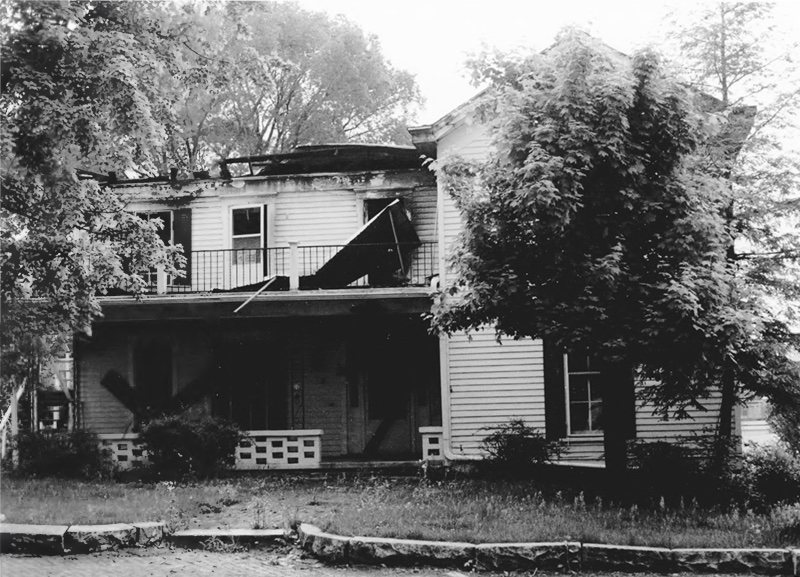
A tour of the East Seventh Street Historic District
Unfortunately, I don’t have the space to give you a full tour of the historic district. But I’ll hit the high points.
We’ll start with Virginia Park. It’s easy to overlook how amazing this park is. At his death in 1909, John C. Latham donated his family homestead to the city to become Virginia Park, named for his mother.
He also gifted $30,000 for landscaping Virginia and Peace parks. The Olmsted Bros. of Brookline, Massachusetts, did the landscape work. This was a really big deal! The Olmsted Bros. were the sons of legendary landscape architect Frederick Law Olmsted, and the firm was the premier landscape architecture company in the country at the time.
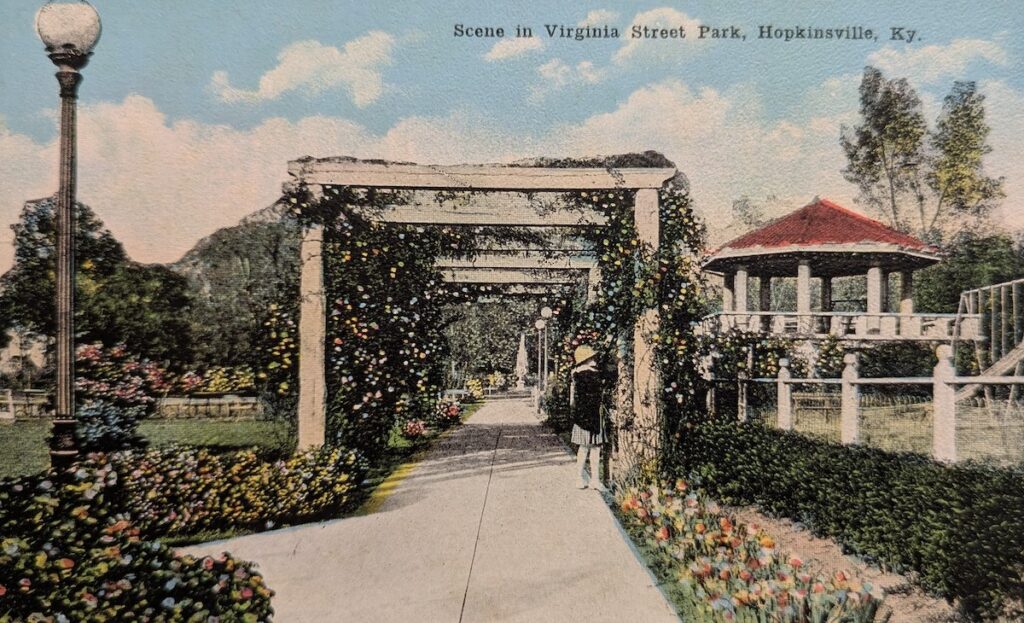
The only building in Virginia Park was to be a pavilion, the structure we call the bandstand. There was also an existing Latham grape arbor that would be converted into a pergola. Virginia Park opened in 1913.
Among the 10 other contributing properties to the historic district that still stand today, there are two brick Queen Annes, two Colonial Revivals, three Craftsmen, one Prairie style (this one is especially exciting, as this style was not common around here in 1910), and one frame cottage. With the exception of the cottage, these homes represent the high-style construction on the street.
Apart from the Smith house at 707 E. Seventh St. eight other contributing buildings on the street have been lost since 1983. These include one brick Italianate, one Greek Revival, two frame Victorians, a wonderful brick Queen Anne built by Lucien Davis before he built the house 719 E. Seventh St., and two frame cottages. Among these were the first mayor of Hopkinsville’s house, the president of the Bank of Hopkinsville’s house, and a house designed and built by Samuel Salter, architect of Western State Hospital and the Blue Lantern.
At least two of these were lost to fire and one to a tornado. Many were demolished. Aside from 818 (the brick Italianate home called Mimosa) and 927 (Lucien Davis’ Queen Anne), all the houses that have been lost were of frame construction, and many were of more modest design than the surviving buildings.
If you’re interested in seeing pictures of these buildings and learning more about their histories, the National Register District nomination and photographs are available here.

Failure to thrive
Harry Smith’s sad end was a harbinger of what was to come. After World War II, Americans began to grow fearful of downtowns. Believing them to be filled with crime, derelict buildings, and insufficient parking, they opted to move their families and businesses out to the suburbs. This bled the lifeblood from downtowns and quickly instigated their decline. As a downtown neighborhood, E. Seventh Street’s decline began directly as part of this flight from the city. I would argue it has never recovered.
This fall, the granite marker announcing the East Seventh Street Historic District and memorializing Chris Hall was removed from the sidewalk. It now sits in a corner of Virginia Park. It’s a fitting symbol of the fate of the historic district, lost somewhere in the cracks between the state and local preservation efforts.
I don’t know if this failure to thrive was due to the early loss of its main cheerleader, Chris Hall, or a combination of factors. Unlike the adjacent Anvirdale and Mount Pleasant districts, the East Seventh Street Historic District never became one of the city’s official historic districts.
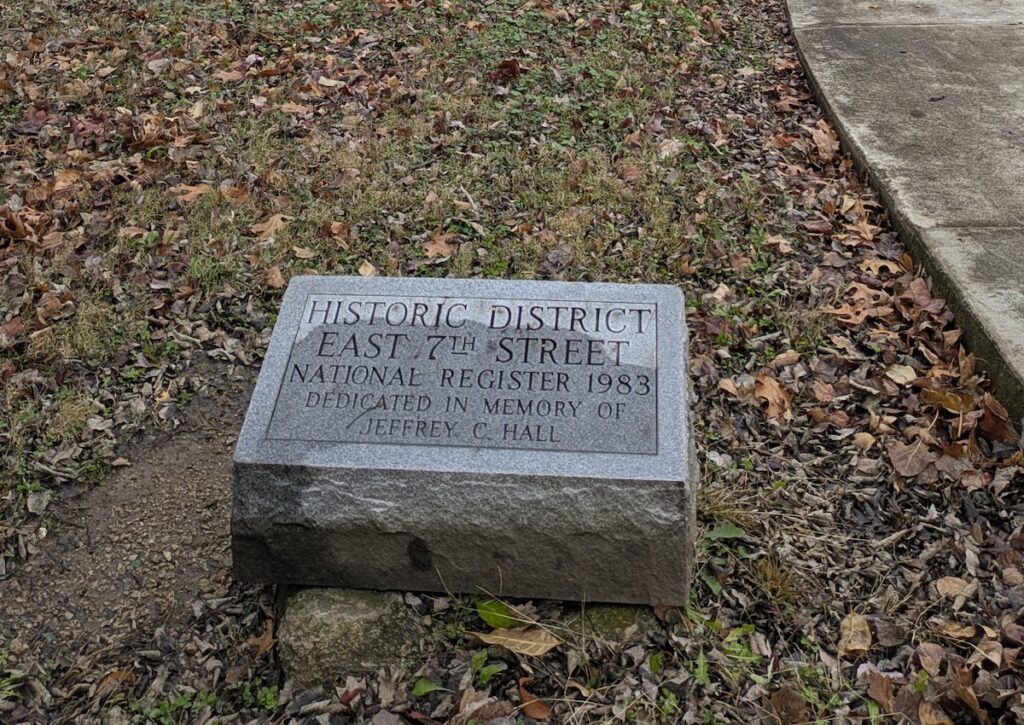
East Seventh Street homeowners were not eligible for financial perks, programs, and guidance available to owners of historic buildings in the two city-designated historic districts. These programs do not save buildings by themselves, but they are powerful tools that encourage and aid preservation efforts. The more localized and grassroots a preservation effort is, the more likely it is to succeed.
With only 10 of its original 19 contributing properties remaining, the East Seventh Street District is Hopkinsville’s forgotten historic district. I think it’s a fair question whether it’s even a viable historic district anymore. While this may seem like a gloomy turn to things, I see valuable lessons, reasons to hope, and a vision for the future. So don’t stop reading now!
Tell me something good!
The bottom half of the East Seventh Street Historic District is largely intact. It has only lost two properties, the Smith house (707) and the Dabney house (608), both of which succumbed to fires. Of the nine remaining contributing buildings in the district, none are abandoned. Two (713 and 719) are actively being restored, and another (812) is undergoing renovations. This is a good sign for the street’s future. Improvements are contagious!
The upper half of the district has unfortunately been decimated. In its current conditions and parameters, I don’t think the historic district is viable. From an architectural standpoint, however, the district never should have stopped at Belmont Street. It should have continued to the Pennyrile Parkway overpass. These six blocks are fairly intact and contain a number of significant historic buildings that would enrich the district. The potential for a viable East Seventh Street Historic District is there.
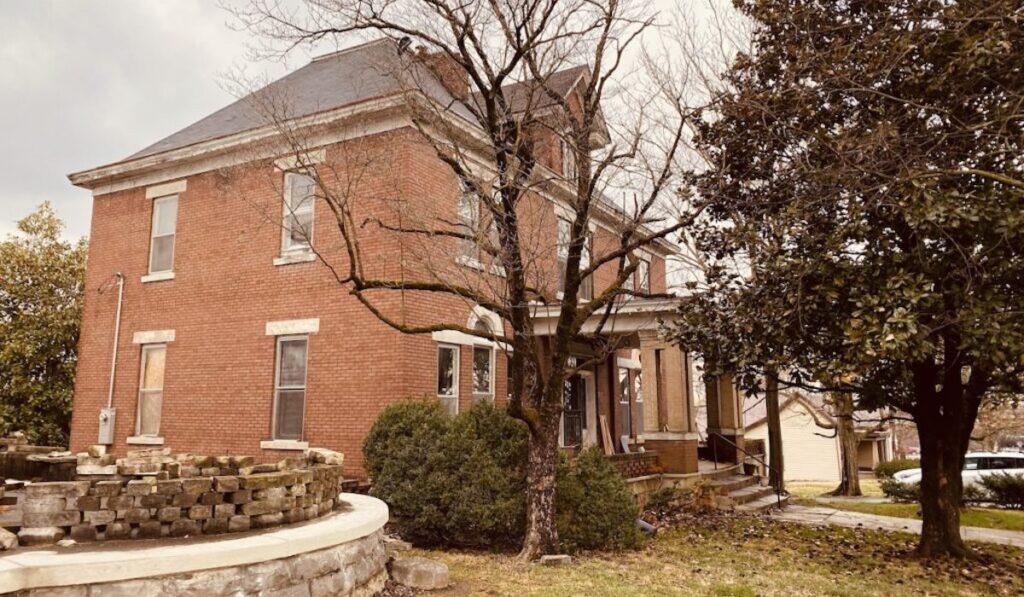
Lastly, downtown Hopkinsville is on the upswing. This month alone, two new businesses have opened their doors downtown — The Crusty Pig and the Book and Bottle Shop. Bringing businesses and patrons back into the city is a fight, but it’s a battle worth waging.
I’m not the only one here who believes this. Hopkinsville has a dedicated population of downtown enthusiasts who make a point of shopping, dining, and hanging out in the heart of the city. And this a population that’s growing.
Maintain this momentum, and the East Seventh Street historic neighborhood — along with the other downtown business areas and neighborhoods — may one day rival what it was when Franklin Roosevelt visited 100 years ago.
Grace Abernethy is a historic preservationist and artist who specializes in caring for and recreating historic architectural finishes. She earned her Master of Science in Historic Preservation from Clemson University in 2011 and has worked on historic buildings throughout the eastern United States. Abernethy was a recipient of the South Carolina Palmetto Trust for Historic Preservation Award in 2014 and won 2nd place in the Charles E. Peterson Prize for the Historic American Buildings Survey in 2011. She and her husband, Brendan, moved to Hopkinsville from Nashville in 2020. She works as an independent contractor and is a board member of the Hopkinsville History Foundation.

